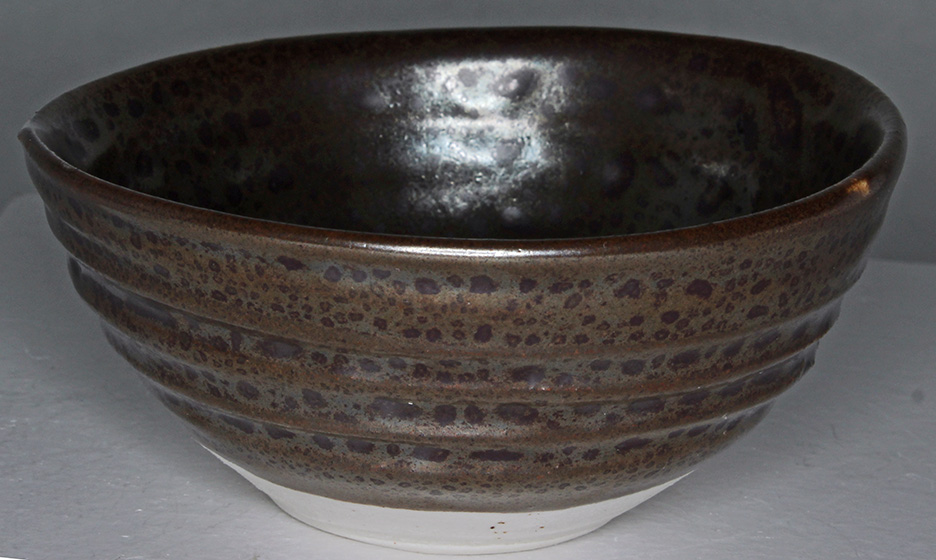oil spot glazes
firing to cone 10 in oxidation
A half hour hold at 1850 deg F
slow downfire at 50 deg F an hour in the interval 1850 deg F to 1700 deg F
slow downfire at 25 deg F an hour in the interval 1700 deg F to 1650 deg F
One hour hold at 1650 deg F
oil spot glazes
The glaze mashikoKaki_3PLiMSi has a lusterous glossy mirror like metallic
surface punctuated with large high contrast oil spots.
The flaw, the
dimples in the oil spots, technically known as "cats eyes" as described in a
recent publication in Ceramic Industry.
I show a step by step migration from this glaze to two glazes which do not
have the cat eyes defect.
This is a report on work in progress, as these
glaze have large high contrast oil spots but are lacking the full gloss
background of mashikoKaki_3PLiMS.
We show below the glaze central to these investigations mashikoKaki_3PLiMSi, which we refer to as the alpha glaze.

The alpha glaze mashikoKaki_3PLiMSi on a 4 inch diameter bowl
The metallic design in this bowl is created with a wash over a mask which is a cutout from plastic shelf paper.
glaze composition
The alpha glaze is high in alkaline earths, with Al2O3 = .8, SiO2 = 5.67,
alk:alumina ratio of .4 and Silica:alumina ratio of 7, mol percent silica
73%.
The variants are all high in alkaline earths, alumina and silica.
alk:al varies from .3 to .45, silica:alumina ratio from 6.4 to 7.5 and mole
percent silica from 73% to 75%.
first steps
The paths to the two cat eyes free oil spot glazes start the same.
step 1. alpha glaze → mashiko_ZG_7 |
decrease alkali metals (increase alkaline earths) |
step 2. mashiko_ZG_7 → mashiko_ZG_H_0 |
replace some CaO with MgO |
The image on top is a closeup of the glaze mashiko_ZG_7, below, stacked vertically are pictures of respectively,
the inside and outside of a small bowl glazed with mashiko_ZG_H_0.
 |
 |
 |
mashiko_ZG_7 has the mirror like glossy background and no cats eyes, however the oil spots are evident only if the glaze is applied thickly.
In the other
direction (not shown, as not used) increasing the alkali metals causes the oil
spots
to dissapear altogether.
The result of replacing some CaO with MgO is more prominent oil spots without bringing back the cats eyes, but now the background is matt.
increase/decrease alumina
We show the effect of increasing and decreasing alumina in the glaze mashiko_ZG_H_0.
Alternative 1. mashiko_ZG_H_0 → mashiko_ZG_H_2 |
increase alumina |
Alternative 2. mashiko_ZG_H_0 → mashiko_ZG_H_1 |
decrease alumina |
The top two images are inside and outside of a small bowl glazed with
mashiko_ZG_H_2, the glaze with increased alumina.
The bottom image is of
the glaze mashiko_ZG_H_1, with decreased alumina.
 |
 |
 |
Increasing alumina results in a more textured glaze, decreasing alumina smooths the glaze, and makes the oil spots more prominent.